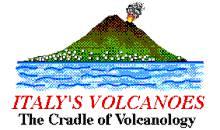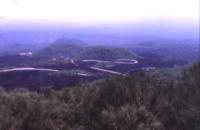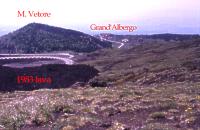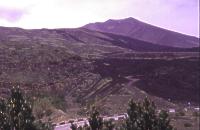 |
Map
of the 1983 lava flow-field
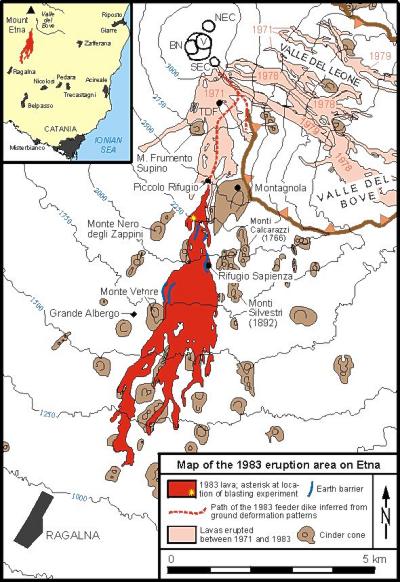 |
This
map shows the area affected by the March-August 1983 eruption on
the S flank of Etna, and sites where operations to divert the lava
flow or prevent it from extending laterally were carried out (yellow
asterisk marks the location where the levee of the main lava flow
channel was blasted in order to force the lava into an artificial
bed; earth barriers erected parallel to the flow margins are shown
in blue color). Ground deformation monitoring allowed the reconstruction
of the path of the subterranean dike departing from near the SE
Crater and leading to the 1983 eruption site immediately below the
"Piccolo Rifugio". Inset at upper left shows the 1983
lava field and locations of various towns on Etna's S, SE and E
flanks. The blasting operation was carried out because the lava
was reported to threat Nicolosi and Belpasso - even if the flow
fronts had advanced further, they would have bypassed Belpasso,
and the farthest flow front stopped about 6 km from the N margin
of Nicolosi (see inset at upper left). Nonetheless, Italian and
international mass media carried the news that even the distant
city of Catania was threatened by the lava flow
|
Photos
of the 1983
eruption and lava flow
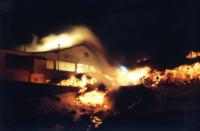 |
On
the first evening of the eruption, the lava flow reaches the large
touristic complex around the Rifugio Sapienza, at about 1900 m elevation
on the S flank of the volcano. Among the first buildings to be destroyed
is the Casa Cantoniera, a restaurant about 200 m to the W of the Rifugio
Sapienza. Photo by Giuseppe Scarpinati, 28 Marchh 1983. |
 |
Two
photos made by Scarpinati on the evening of 2 April 1983 at the mildly
explosive vents of the 1983 eruption. The eruptive fissure lay on
the W base of the Montagnola, of which part is visible in the background
in the right photo. |
 |
 |
Left: Detail of the 1983 hornitos, which built around the skilift
leading to the Montagnola skiing area
Right: Bifurcating lava flow in the upper part of the 1983 lava flow-field.
Photos by Scarpinati |
 |
Continue
with
THE 1984 SE CRATER ERUPTION
|
